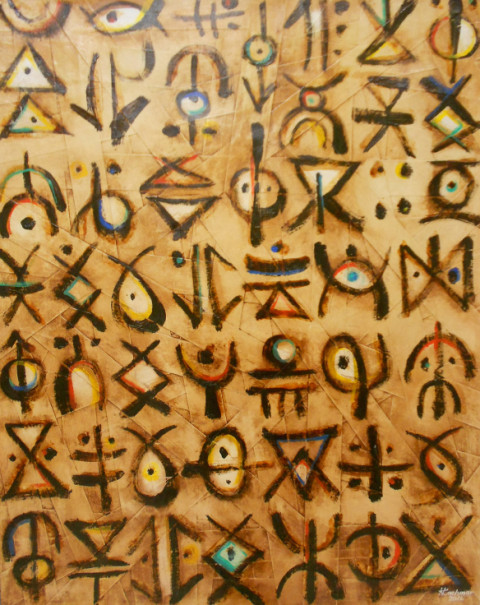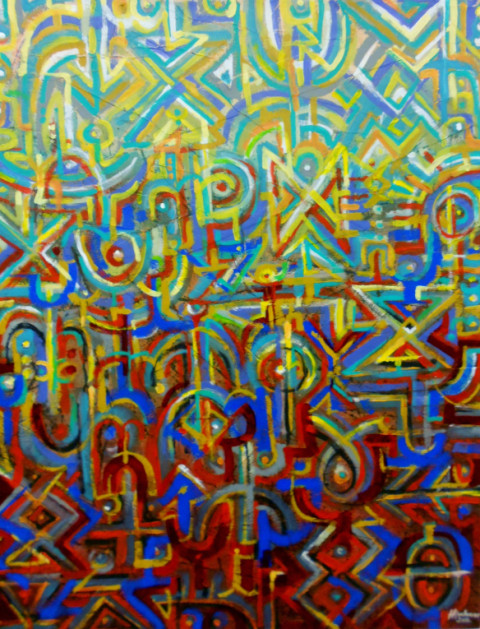Hamid Kachmar’s Art
Via Boston.com’s Brainiac, this info on an Amazigh (Berber) artist whose show I would love to catch ‚ but can’t, unhappily. If in or around Boston, try to do so.
Using art to preserve an endangered language
Posted by Kevin Hartnett October 7, 2013 01:10 PM
How do you preserve a language that’s in danger of being forgotten? Turn it into art. The Sherman Gallery at Boston University is currently running an exhibitionof works by Moroccan artist Hamid Kachmar, who for twenty years has been using his paintings to help keep alive an embattled, indigenous language.Tifinagh is the ancient script of the Berbers, a minority ethnic group in Morocco to which Kachmar belongs. Tifinagh has been suppressed historically in Morocco, but Kachmar makes the script’s intricate symbols the main element of his colorful art. In some pieces, like the first one below, “Timitar 1 Symbols in Symbiosis,” the symbols are presented in neat fashion, as if they were being catalogued. In others, like the bottom image, “Tafsut Berber Spring,” Kachmar uses the symbols in more abstract form, to create images that evoke the Berber language’s complicated place in Moroccan culture.
“Hamid Kachmar: Reviving the Ancient Tifinagh Script ” runs at the Sherman Gallery from September 6-October 20.
BU’s Visual Arts pages give the following information:
In Reviving the Ancient Tifinagh Script, Kachmar renders the ancient Amazigh script, Tifinagh, into textual and visual compositions that represent a struggle for identity, cultural survival, and self-conception. For centuries, the Tifinagh script has been politically suppressed; painted out of Amazigh people’s collective consciousness. For Hamid and many other cultural activists of his generation, Tifinagh represents not just the ancient script of a still widely spoken indigenous language, but also a symbol of the struggle for cultural survival.
Kachmar’s materials and techniques evoke metaphors, moods, and expressions of his home country and his experiences abroad. Hamid uses the Tifinagh script and Amazigh motifs in written, painted, carved, and woven compositions that are sometimes overtly textual and sometimes purely visual without any semantic meanings. The artist states,
“Tifinagh script has been omnipresent in my work for more than two decades. It is a very intimate, loyal, and existential relationship that has linked the script of my mother tongue, Tamazigh, and me; a relationship that began at age thirteen when I first knew that my Amazigh “Berber” language had a script of its own.”
The exhibition is curated by Cynthia Becker, Associate Professor of Art History, in Boston University’s Department of History of Art and Architecture and presented as part of Boston University’s African Studies Center 60th Anniversary celebration.
Images courtesy of the Boston University College of Fine Arts.
This blog is not written or edited by Boston.com or the Boston Globe.
The author is solely responsible for the content.



 Poasis II: Selected Poems 2000-2024
Poasis II: Selected Poems 2000-2024 “Todesguge/Deathfugue”
“Todesguge/Deathfugue” “Interglacial Narrows (Poems 1915-2021)”
“Interglacial Narrows (Poems 1915-2021)” “Always the Many, Never the One: Conversations In-between, with Florent Toniello”
“Always the Many, Never the One: Conversations In-between, with Florent Toniello” “Conversations in the Pyrenees”
“Conversations in the Pyrenees” “A Voice Full of Cities: The Collected Essays of Robert Kelly.” Edited by Pierre Joris & Peter Cockelbergh
“A Voice Full of Cities: The Collected Essays of Robert Kelly.” Edited by Pierre Joris & Peter Cockelbergh “An American Suite” (Poems) —Inpatient Press
“An American Suite” (Poems) —Inpatient Press “Arabia (not so) Deserta” : Essays on Maghrebi & Mashreqi Writing & Culture
“Arabia (not so) Deserta” : Essays on Maghrebi & Mashreqi Writing & Culture “Barzakh” (Poems 2000-2012)
“Barzakh” (Poems 2000-2012) “Fox-trails, -tales & -trots”
“Fox-trails, -tales & -trots” “The Agony of I.B.” — A play. Editions PHI & TNL 2016
“The Agony of I.B.” — A play. Editions PHI & TNL 2016 “The Book of U / Le livre des cormorans”
“The Book of U / Le livre des cormorans” “Memory Rose Into Threshold Speech: The Collected Earlier Poetry of Paul Celan”
“Memory Rose Into Threshold Speech: The Collected Earlier Poetry of Paul Celan” “Paul Celan, Microliths They Are, Little Stones”
“Paul Celan, Microliths They Are, Little Stones” “Paul Celan: Breathturn into Timestead-The Collected Later Poetry.” Translated & with commentary by Pierre Joris. Farrar, Straus & Giroux
“Paul Celan: Breathturn into Timestead-The Collected Later Poetry.” Translated & with commentary by Pierre Joris. Farrar, Straus & Giroux
A laudable goal beautifully expressed. Taken purely as art, his work would brighten any room.
We own “the Gate” “Gateway” by Hamid Kachmar. we purchased it about ten years ago at the Parish Galery in Georgetown. It’s a fine piece, but we are considering selling it. It is a two piece mixied medium. It may even be titled Gateway to Peace. We have no idea what it would be worth now or who might be interested in purchasing it. Please advise.